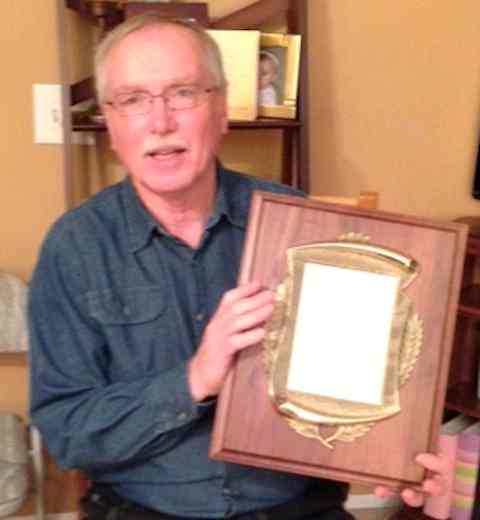 |
Flying High With Electric Power!
The Ampeer ON-LINE!
Fly the Future - Fly Electric! |
|---|
Site Table of Contents
| President: | Vice-President: | Secretary-Treasurer: |
| Ken Myers | Richard Utkan | Rick Sawicki |
| 1911 Bradshaw Ct. | 240 Cabinet | 5089 Ledgewood Ct. W. |
| Commerce Twp., MI 48390 | Milford, MI 48381 | Commerce Twp., MI 48382 |
| (248) 669-8124 | (248) 685-1705 | (2480 685-7056 |
 | ||
| Board of Directors: | Board of Directors: | Ampeer Editor |
| David Stacer | Arthur Deane | Ken Myers |
| 16575 Brooklane Blvd. | 21690 Bedford Dr. | 1911 Bradshaw Ct. |
| Northville, MI 48168 | Northville, MI 48167 | Commerce Twp., MI 48390 |
| (248) 924-2324 | (248) 348-2058 | (248) 669-8124 |
| The Next Meeting: Date: Wednesday, February 10 Time: 7:30 p.m.
Place: Ken Myers' house (address above) | ||
| The December EFO Meeting Highlights and photos from the Dec. 2015 EFO Meeting. | Help With a Scratch-Built Champ John Tice asked for some help with project and Ken responds. |
| AeroFly RC7 Update 7.4.7 Ken Myers shares info on the most current update to AeroFly RC7. | What's Going on With LiPo Battery Suppliers? Ken describes some problems he has had when ordering some LiPo batteries. |
| A HobbyKing.com Gripe Continued Ken continues to describe his frustrations with Hobby King. | Hitec X4 Micro Charger and Getting the Correct Cables Dave Stacer explains how he FINALLY got the right charger cables for this Micro Charger. |
| Upcoming Keith Shaw Birthday Party Electric Fly-in 2016 Meet announcement from Dave Grife. | |
The attendance at the December meeting was fantastic. There was a lot of very good sharing and it was a really good time. At the end of the 'formal' meeting, Ken presented this information and some of the accompanying videos. They are suggestions for winter projects for those of us in the northern hemisphere. Batteries 1. Remove dry cells from transmitters that use them and store them in a cool, dry place.
Now is a good time to set up your transmitter(s) to improve the flyability of your planes. Following the examples from Motion RC is good idea. Very Important: Remove the prop before following any of the outlined procedures Bind and Fail Safe (9:30)
Setting up your radio to actually fit your hands and the way you fly (19:38)
Programming to smooth out your flying (18:47)
RC Model Reviews: How to install 2.4GHz (22:44) Spektrum AR600 Antenna Placement (5:42) Installing the Spektrum AR600 receiver (14:38) Perform a complete physical check of all aircraft. Make any repairs or adjustments as soon as they are discovered. Do NOT put off any 'fixes' for another day.
After his winter projects presentation, Ken showed a Thermocouple Thermometer that he's using in conjuntion with the Wayne Giles ESR meter for some LiPo battery testing. "It is the Signstek 3 1/2 6802 II Dual Channel Digital Thermometer with 2 K-Type Thermocouple Sensor Probe for BGA rework HVAC 13000C 23720F.
We found out, at the EFO meeting, that Richard Utkan, is another Carl Goldberg Award recipient in our area. He's been the vice-president of the EFO since its inception in February 1988. We started the Union Lake Flying Organization in the late 70's or very early 80's. (Remember, we were flying glow planes way back then.) We flew off Wise Rd. near Union Lake, MI. The UFO club had to move because of noise complaints. Their field is now near Highland, MI, off Duck Lake Rd. They are now called the United Flying Organization. He's an active instructor there and helps with all club projects. He was presented the award at the UFO annual Christmas meeting. Keith Shaw and I 'welcomed him to the club' of award winners in our area. Richard lives in Milford, MI. 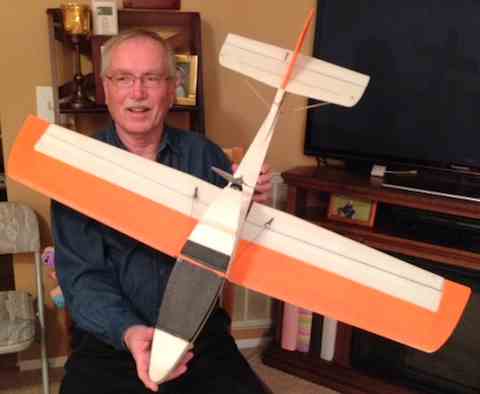 Richard Utkan shared is 23 oz. M6 Mermaid. He's been flying it off a pond across the street from where he lives. It uses a 370 brushless outrunner, 40 Amp ESC and 3S 2200mAh LiPo battery. It was built from a kit. The foam kit is available from www.kenscadmodels.com. 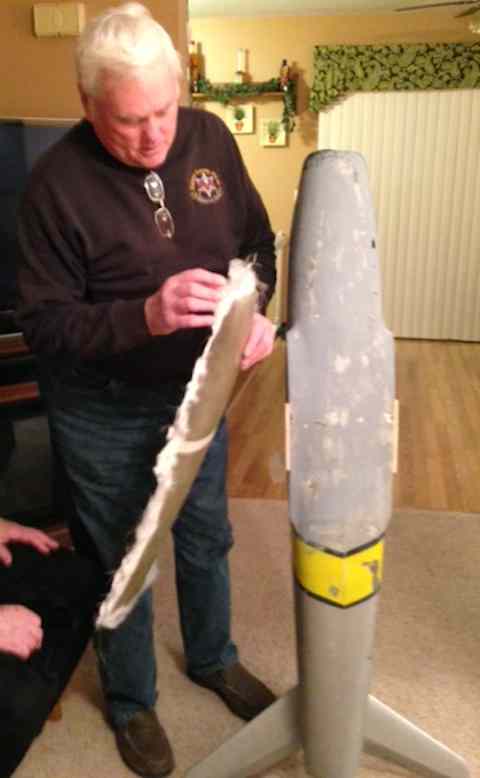 Hank Wildman shared his big F-86. He showed the new fiberglass bottom of the fuselage he made. The new bottom will accommodate a 'cheater hole' and the nose gear retract with working gear doors. He noted that he really like working with West System products on this project. 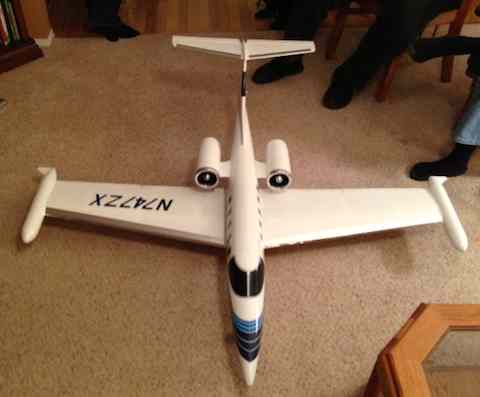 He also brought along his Kyosho Lear Jet. It is finished now. It weighs 7 pounds and features retractable landing gear and flaps. 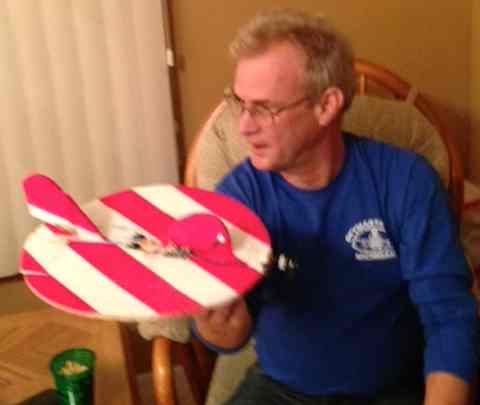 Pete Foss shared his modified LazerToyz Mini Nutball Kit Combat Version EPP foam plane. He found that, as built to plan, it would not roll well and the plane really wanted to stay inverted. He modified the plane by removing much of the dihedral and adding elevons. That didn't seem to help much in the rolls. He moved the CG forward, by adding weight, and now it rolls very well. He uses an E-flite 180 brushless motor and a 2S 300mAh LiPo battery. He used the guts from a non-AS3X plane for onboard radio gear. 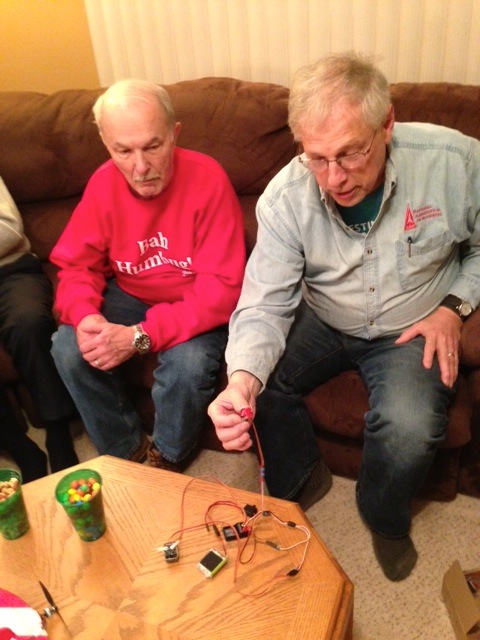 Roger Wilfong shared a pulse actuator and also a Rand pulse rudder system that he will be installing in a new Minnie Mambo made from Ken Myers' plans. More information about this type of control can be found at Phil & Shaun's Single Channel & Vintage R/C Page. Roger has had to do quite a bit of experimenting to get the voltages right for use with our modern RC gear. 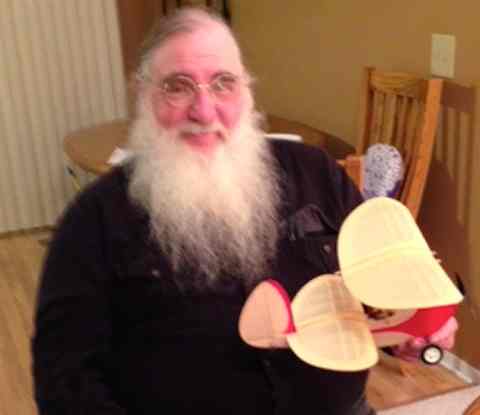 Keith Shaw shared his Stevens Aeromodel S-POU!TM V2.4 Micro RC Kit [SAK-SPOU!2.4]. Pete Foss called Keith two days before the Horizon Indoor meet in Columbus, OH, this year and wanted to know if he was going. Keith had been to the meet before, and he'd enjoyed it. He built his cartoon scale version in two days. The covering on his plane is Nelson film. He notes that it has an extremely sensitive CG placement, and getting the CG right is critical! He modified the elevator control system by adding a rubber band to keep from having too much slop in the bellcrank and pushrod. The 'elevator' is actually a pushrod that moves the trailing edge of the wing up and down. Keith also had some extra time during his build, before he left for Ohio, so he built a very nifty transport box. He did not glue on the rear wing. The rear wing is held on with rubber bands so that it comes apart easily to fit in the box. The meeting ended with our general bull session and refreshments. This is the way model airplane club meetings are supposed to be! Great job guys! Help With a Scratch-Built Champ
October 9
I see from your web page you know lots about RC electric design. I tried to fly my scratch build champ today and it flew very poorly for about 7 seconds and crashed. I am curious as to why. I suspect it is a weight or balance issue. If I were to send you some technical information would you be willing to help me? It is not too badly damaged and I would like to modify her to flyable. Thank you
Oct. 11 Hi John, I'd be happy to lend a hand. Be sure to include ALL of the power system details. For the airframe, include the ready to fly weight and be sure to include the wing area and chord. Also include the chord, or average chord, of the control surfaces and the control throw, either in degrees or inches from center. Hope to hear from you soon,
October 24
I gathered the information on my scratch built Champ. It flew poorly the first time because it was tail heavy. I modified the battery placement more forward and it balanced long wise (pitch) with the battery and in ready to fly state is perfectly level at the CG I inked on the wing between 30% and 33% from leading edge. I flew it the second time and crashed it because I tried to fly it myself and I should have waited for my club test pilot. I am repairing the damage now and believe to have it ready for tomorrow. Here are the specs: Ready to fly weight is 37 ounces. I was trying to keep it under 35 oz.
I appreciate your insight into this design. Thank you
Oct. 24
Wingspan (it is measured tip to tip with no dihedral taken into account - in other words the plan view) about (~ this is the symbol for about or approximately) 47.25" from the data you've given me Wing Area: 47.25" x 7.125" = 336.7 sq.in. a bit taken off because of the angle at the wing tip, so approximately 330 sq.in. 330 sq.in. divided by 144 sq.in. (one square foot in sq.in.) is about 2.3 sq.ft. Area Wing loading: 37 oz (your given weight) divided by 2.3 sq.ft. is about 16 oz./sq.ft. Not too bad. Wing Cube Loading = 2.3 sq.ft. raised to the 1.5 power = 3.49 and then
The approximate stall speed: the square root of 16 oz./sq.ft. (wing area loading) times 3.7 = 4 times 3.7 = 14.8 mph or ~ 15 mph Your Center of Gravity (CG) is still too far reward at 33% of the mean aerodynamic chord (MAC). For a 'safe' initial flight it should be 25% of the MAC of 7.125"
Your low rate aileron throw should be fine for the maiden. Your elevator low rate is too high at 0.75". Both Cubs and Champs tend to be quite pitch sensitive. For the remaiden, I would recommend a maximum 0.5" each way, and even that may be too much. The rudder doesn't really need any fiddling with, unless you are 'over-steering' on the ground, then you can cut it down some. For a plane with the ability to fly on its own, like this Champ, more throw does NOT get you out of trouble, it gets you into trouble. I hope this helps,
December 13
I just wanted to let you know that yesterday we re-maidened my scratch built Champ and she flew very well with no bad tendencies. It is so rewarding to see your project take wing. I was smart and let our chief club instructor do the flying in relatively calm winds, and it was great. Just as you mentioned, it is a bit pitch sensitive but not problematic. I have a short video but it's quite a large file and The model looks like it is a mile away and shaky as I was so excited. Thanks for your help. The CG was the number one issue and a mistake I will not be making again. The throws were tweaked per your suggestions and you were spot on. I am hooked on this big time.
AeroFly RC7 Update 7.4.7
I presented a review of this flight simulator program in the January 2015 Ampeer. I had last used the program in the spring of 2015 to practice four point rolls, slow rolls and rolling circles. When I tried to open the program again on December 27, my computer noted that the file had been corrupted and that I needed to download it again from the Apple App Store. I was not thrilled about this, even though it didn't cost me anything. The file is HUGE and takes forever to download over my DSL line. The latest version is 7.4.7. I had reviewed version 7.0.7. The Standard version of the program was $44.99 plus Michigan sales tax when I downloaded it in the spring of 2014. When I was at the Apple App Store, I noted that it had a new price of $39.99. The next morning, after the download had completed, I checked to see if there was a new manual. I found the new manual. The 'odd' thing is that the original manual, that I downloaded from in 2014, has the same version number, 1.4, as the new manual. The newer manual has two less pages. The biggest change in the new manual was in the contact information at the end of the new manual and the new Appendix: Keyboard Shortcuts. The cover page has a new graphic and new contact information. The table of contents has a link to the Keyboard shortcuts added. There is a reference to the Landing guide line in the older version of the manual, but it never linked to anything. The reference was removed from the newer manual, yet the function is still there. The function, and how it operates, is described in section 10.3. The new version of the program still runs fine on my laptop under Mac OS X version 10.7.5. As I noted in the full review, all simulator programs, including this one, suffer in the vertical. Simulators are best used to practice horizontal flying maneuvers. Simulators are not very good at teaching the proper line up for good landings. The perspective is just wrong. The good news is that now I have the simulator running again, I can continue my testing and evaluation of LiPo batteries. What's Going on With LiPo Battery Suppliers?
On November 22 I ordered a Dinogy 3S 1000mAh 30C and a 3S 1000mAh 65C. Two batteries arrived on November 28. One was a 3S 1000mAh 30C and the other was a 3S 800mAh 65C. I notified Mark at Dinogy LiPos and a 3S 1000mAh 65C was sent, and I returned the 800mAh pack. The correct pack arrived on December 4, 2015. I documented my problems with my Hobby King order of three LiPo batteries in last month's Ampeer, and it continues next in this issue. Bottom line, I only got two of the three batteries I ordered. On December 16, I ordered a RevoBlends 420 3S 1000mAh 60C. A battery arrived on December 23. The battery says it is a 3S 1000mAh, but its weight (119.3g) and the measures are that of a 1300mAh. I notified John Grzan (AKA REVOJohn) about the problem on Dec. 24. After an exchange of emails, he shipped a replacement on December 29. A total of eight 3S 1000mAh batteries were ordered for my testing and evaluation. Two of the ones received were the wrong battery, and one was never received. That is, 3 out of 8 were either shipped wrong or never arrived. That is a whopping 37.5% failure to deliver what was ordered. That is three problems that I had to handle and should not have be required to! What's up with that? I must add, that unlike Hobby King, both Mark at DinogyLiPos and John at Revolectrix kept me well informed via emails as to how they were handling the problem, when the replacement was sent and tracking numbers. Both are great guys to deal with! A HobbyKing.com Gripe Continued
This journey started in the January 2016 Ampeer. On November 24, 2015 I placed an order for three different 'brands' of 3S 1000mAh LiPo batteries, using the East Warehouse (AR). All were said to be in stock when I placed the order. I had received no packs and no notice from Hobby King regarding these packs by the time the January Ampeer issue was posted on Dec. 18, 2015. Two of the packs arrived on Dec. 19. That figures. At that time, there still had been no notice to me about the packs. The two just showed up in the U.S. postal service mail. The Turnigy nano-tech 1000mAh 3S 45~90C LiPo was not shipped. The packing list, which had no pricing on it, indicated that the nano-tech 45~90C was cancelled, but it also indicated that it was on a new order. Very confusing. To add to the confusion, I had checked on December 14 and the first two were still in stock, but the nano-tech 1000mAh was said to be out of stock. On December 16, I checked and 3 of the nano-tech were said to be in stock. December 17, I checked the warehouse east stock and it was down to 1. December 18, the warehouse east stock was noted as 0. Will I ever get the nano-tech 3S 1000mAh 45~90C? Your guess is as good as mine. I started to evaluate the two packs that I did receive. I let the packs rest on the main floor of my house overnight. I began gathering the preliminary data for my testing on the morning of Dec. 20. Preliminary indications were that the Turnigy 3S 1000mAh 30C was 'duff'. All of the the voltages looked good on my CellMeter-8 and PowerMatch voltage checkers. The voltages even looked good when charged at 1 amp on my CellPro 10XP, and the battery 'appeared' to have charged somewhat normally. Unfortunately, the Wayne Giles ESR meter showed the #2 cell as out of range for the IR reading. The last time that happened was on a borrowed Genesis 3S 1300mAh 25C pack. That pack turned out to be 'useless'. The Turnigy pack's final performance, under load, will be presented and compared to other 3S 1000mAh packs in an upcoming Ampeer. For now, let's just say it was less than stellar. What I did confirm is that just relying on voltage checkers, and even the charger data, does not show up a pack which will not hold a charge and be useful. The voltages have to be checked under load, just like all other batteries. Dec. 31, 2015
Hobby King has a new layout for their Web site page and now the in stock or out of stock appears in a tab to the right of the product description. If the product is in stock, it no longer notes how many are in stock, but that it is supposed in stock. Both of the USA warehouses show the pack in stock, while the International warehouse notes that it is out of stock. I checked my mailbox, but still no joy. Hitec X4 Micro Charger and Getting the Correct Cables
My family has been having a blast flying the Estes Proto-X that I won at the CARDS meet last summer. We mostly fly it indoors in the family room but have taken it outside when there is no wind. The controller that came with it was too small to be comfortable in most adult hands, so I purchased the SLT version. This one works with the Tactic transmitter so I can use the same transmitter that I use for my larger airplanes. The SLT version also has an easily replaceable battery and this is where my charging expedition begins. The flight time on a single cell (100mAh) is 3-4 minutes then 20 minutes of charging with their supplied USB charge cable. That is just too long to wait for next flight. The eBay seller, where I purchased the Proto-X SLT version, also included two extra batteries. I also purchased some more batteries so we can almost fly continuously. My first attempt at charging was to build a cable to charge three at once using my CellPro10S that supports node only charging (charging using only the balance port). Hobby King has a nice cable that has 6 of the proper picoblade connectors on it. (https://goo.gl/B2cL6j) I harvested the connectors and made up a cable that would connect up to the 10S. I used my multi-meter to monitor one of the charging cells and even though I told the charger to charge at 100mAh I would see spikes much higher. It turns out the balance cycle doesn't seem to balance at a lower current. I didn't like that at all. 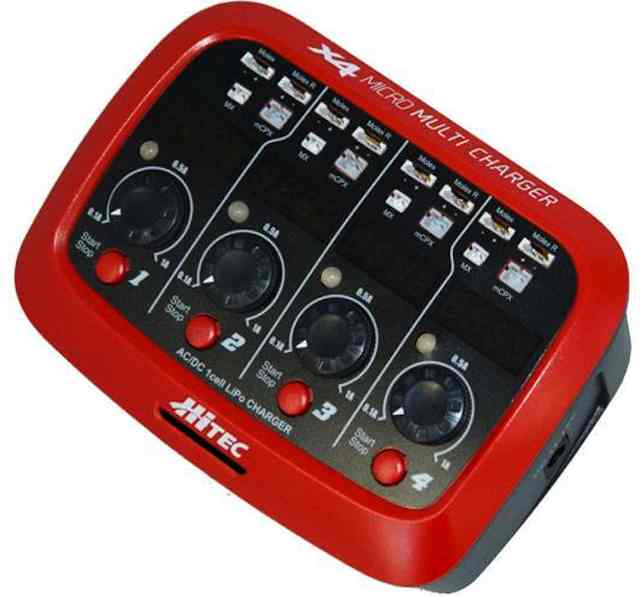 I purchased the Hitec X4 Micro charger to solve the problem. This charger has four separate charge channels and you can set each channel from 0.1A to 1 A. The charger has four connectors per channel.  The connector labeled MX looks like it is the correct one but the connector from the Proto-X battery didnÕt easily fit, so I didnÕt force it. I tried the 150mAh cells from my Flyzone Playmate and it didnÕt fit either. In the charger box were two separate cables that were not listed anywhere in the documentation. The bottom one in the photo fit the battery connector.  Problem solved but I needed 3 more of these cables so I could use the charger for what I wanted to do. I e-mailed Hitec support, explained what I was trying to charge and asked what the connectors were called so I could get the correct connectors to make up more adapter cables. They responded that I could purchase them from Tower Hobbies. http://www3.towerhobbies.com/cgi-bin/wti0001p?&I=LXFCVE&P=7 $9.99. Ouch, 20% of the charger price to get the proper cables? Hitec support said they shouldn't be that much but offered to send me three additional cables. I received the cables from them and my problem was solved; I can now charge four cells at a time. Since Hitec would not tell me what the connectors are, I did some more research and from various resources (listed below) I have identified the real connector names that are on this charger.  The connector on the Proto-X battery, Flyzone Playmate and many of the BNF single cell battery is the ÊMolex Picoblade1.25mmÊ53047 Series connector. If you look, with some magnification, the connector is two rectangle blades vs. square posts. Conclusions:
References:
Adapter cables
Upcoming Keith Shaw Birthday Party Electric Fly-in 2016
The Balsa Butchers will once again be hosting the "Keith Shaw Birthday Party Electric Fly-In" at their field near Coldwater, MI. The event will take place on Saturday June 4, 2016. It will be a one day meet this year. The event consists of Open Electric Flying with a "Special Guest of Honor Theme". Enjoy a day with the "Pioneering Master of Electric R/C Flight". 8 am - 5 pm Saturday, $10 landing fee. For additional information contact Dave Watson 517-250-6190 or email: flybuddy619@yahoo.com
The field will be open to guests to fly Sunday as well. Directions: Quincy is approximately 4.5 miles east of I-69. Clizbe Road is approximately 1.6 miles east of Quincy. The Flying site is approximately 1.5 miles south of US-12 on the west side of Clizbe Road. 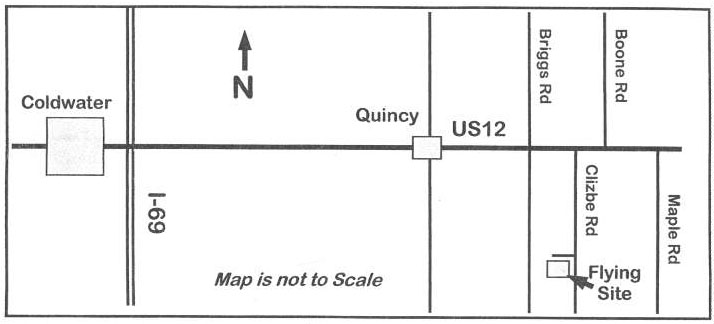 To Reach Ken Myers, you can land mail to the address at the top of the page. My E-mail address is: KMyersEFO@theampeer.org |

